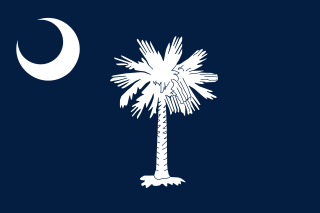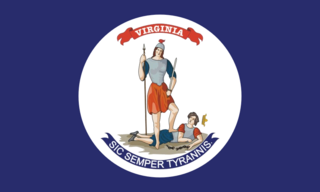
James Dearing was a Confederate States Army officer during the American Civil War who served in the artillery and cavalry. Dearing entered West Point in 1858 and resigned on April 22, 1861, when Virginia seceded from the Union. Dearing was mortally wounded at the Battle of High Bridge during the Appomattox Campaign of 1865, making him one of the last officers to die in the war. Despite serving as a commander of a cavalry brigade and using the grade of brigadier general after he was nominated to that grade by Confederate President Jefferson Davis, Dearing did not officially achieve the grade of brigadier general because the Confederate Senate did not approve his nomination. His actual permanent grade was colonel.

Hampton's Legion was an American Civil War military unit of the Confederate States of America, organized and partially financed by wealthy South Carolina planter Wade Hampton III. Initially composed of infantry, cavalry, and artillery battalions, elements of Hampton's Legion participated in virtually every major campaign in the Eastern Theater, from the first to the last battle.

The 3rd Arkansas Infantry Regiment was a regiment of the Confederate States Army during the American Civil War, and the most celebrated unit from the state. Formed and initially commanded by Colonel Albert Rust, and later falling under the command of Colonel Van. H. Manning, the regiment was part of the Army of Northern Virginia, serving under General Robert E. Lee. The 3rd Arkansas Infantry Regiment served for the duration of the war, from the late months of 1861, through to its surrender at Appomattox Court House in 1865. It was the only regiment from the state of Arkansas to serve the entire war in the Eastern Theater, where most of the major Civil War battles were fought. It was also the only Arkansas regiment to initially sign up for the duration of the Civil War, with all other regiments from the state signing on for a one-year enlistment.

The 4th South Carolina Cavalry Regiment was a regiment of cavalry in the Confederate States Army during the American Civil War. They were from the state of South Carolina and served primarily in the Eastern Theater of the American Civil War. The 4th South Carolina Cavalry Regiment was organized on December 16, 1862, by consolidating the 10th Battalion South Carolina Cavalry, the 12th Battalion South Carolina Cavalry, the Charleston Light Dragoons and Company A of the St. James Mounted Riflemen. The 10th Cavalry Battalion was organized in the spring of 1862 with five companies, and Major James P. Adams and Major William Stokes were the commanding officers. The 12th Cavalry Battalion had also been known as the 4th Cavalry Battalion.

The 26th Virginia Infantry Battalion was a unit of the Confederate States Army organized on May 20, 1862 from men of the 59th Virginia Infantry Regiment who were not captured at the Battle of Roanoke Island and additional companies of recruits. It was commanded by Lt. Col. George M. Edgar and, after his capture in 1864, by Capt. Edmund S. Read. The battalion was disbanded on April 12, 1865 by Brig. Gen. John Echols at Christiansburg, Va.

The 64th Virginia Mounted Infantry Regiment was formed from troops raised in Lee, Scott, Wise and Buchanan counties in Virginia for service in the Confederate States Army during the American Civil War. It served as an infantry regiment, a cavalry regiment, and a mounted infantry (dragoon) unit, and had a mixed reputation.
The 1st Regiment Kentucky Volunteers, CSA was an infantry regiment that served in the Confederate States Army during the American Civil War. It was the only Kentucky regiment in the Confederate service to serve in the Army of Northern Virginia.

The 5th Virginia Cavalry Regiment was a cavalry regiment raised in Virginia for service in the Confederate States Army during the American Civil War. It fought mostly with the Army of Northern Virginia.

The 11th Virginia Cavalry Regiment was a cavalry regiment raised in Virginia for service in the Confederate States Army during the American Civil War. It fought mostly with the Army of Northern Virginia.

The 24th Virginia Cavalry Regiment was a cavalry regiment raised in Virginia for service in the Confederate States Army during the American Civil War. It fought mostly with the Army of Northern Virginia.

The 2nd Tennessee Cavalry Regiment, also known as the 22nd Tennessee Cavalry after it was consolidated with the 21st Tennessee Cavalry (Wilson’s), was a cavalry unit of the Confederate States of America during the American Civil War, organized on June 12, 1862. The unit was originally commanded by Lieutenant-Colonel Clark Russell Barteau, who was promoted from the rank of private on the day that he was placed in command of the new regiment. He was promoted to colonel a year later.
The Jeff. Davis Legion was a cavalry regiment of the Confederate States Army. Made up of companies from Mississippi, Alabama, and Georgia; it fought primarily in the Eastern Theater of the American Civil War. In 1865, it was reassigned to the Army of Tennessee, surrendering at Greensboro, N.C.

The 11th Arkansas Infantry (1861–1865) was a Confederate Army infantry regiment during the American Civil War. Following the units surrender during the Battle of Island No. 10, it was consolidated with Griffiths 17th Arkansas Infantry Regiment and mounted. Following the surrender of Port Hudson, some unit members returned to Arkansas and became part of Poe's Arkansas Cavalry Battalion and Logan's 11th Arkansas Cavalry Regiment.

The 2nd Arkansas Cavalry Regiment (Slemons') (1861–1865) was a Confederate Army cavalry regiment during the American Civil War. This regiment was also referred to in the official records as the 4th Arkansas Cavalry Regiment. Another regiment, commanded by Colonel Thomas J. Morgan, was also designated as the 2nd Arkansas Cavalry Regiment. Following Price's Raid in 1864, the survivors of the regiment were reorganized as the 18th Arkansas Cavalry Battalion, which was also referred to as McMurtrey's Arkansas Cavalry Battalion.
The Chew's Arkansas Infantry Battalion (1862) was a Confederate Army infantry battalion during the American Civil War. The unit was originally known as Hawthorne's Battalion, but the battalion is most often referred to as Chew's Sharpshooter Battalion. The unit was eventually consolidated with the 39th Arkansas Infantry Regiment.

The 1st Florida Infantry Regiment was an infantry regiment raised by the Confederate state of Florida during the American Civil War. Raised for 12 months of service its remaining veterans served in the 1st (McDonell's) Battalion, Florida Infantry from April 1862 on. In August the depleted battalion was consolidated with the 3rd (Miller's) Battalion into the reorganized 1st Florida Infantry Regiment again. In December 1862 it merged with the 3rd Florida Infantry Regiment and received the form it kept till the war's end as the 1st and 3rd Consolidated Florida Infantry Regiment. Fighting as part of the Army of Tennessee in the Western Theater of the American Civil War it was surrendered on April 26, 1865.

The 24th and 25th Consolidated Texas Cavalry Regiment was a unit that originally consisted of two regiments of mounted volunteers that served in the Confederate States Army during the American Civil War. However, by the time the two regiments were consolidated, they fought as infantry. Both regiments organized as cavalry near Hempstead, Texas in April 1862 and were dismounted to fight as infantry in July 1862. The two regiments served in the same brigade and were captured at the Battle of Arkansas Post in January 1863. After being sent to Northern prison camps, the soldiers were exchanged in April 1863. Assigned to the Army of Tennessee, the two regiments were consolidated with two additional Texas cavalry regiments and in 1863 fought as infantry at Liberty Gap, Chickamauga, Missionary Ridge, and Ringgold Gap. In 1864, the other two Texas regiments were detached and the consolidated 24th and 25th fought as a separate infantry unit in the Atlanta campaign, at Franklin, and at Nashville. For the Carolinas campaign, the 24th and 25th fought at Bentonville before being reconsolidated with other Texas regiments and surrendering in April 1865.

The Battle of Lewisburg occurred in Greenbrier County, Virginia, on May 23, 1862, during the American Civil War. A Union brigade commanded by Colonel George Crook soundly defeated a larger Confederate force commanded by Brigadier General Henry Heth. Panicked Confederate forces escaped by crossing and burning a bridge across the Greenbrier River.









